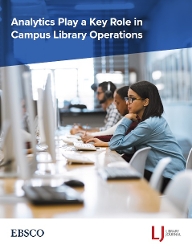Academic Librarians View Analytics as Vital, but Want Less Expensive, Easier Tools
Ninety-one percent of academic librarians believe that analytics improve their understanding of how students, faculty, and researchers engage with their library, and 85 percent believe analytics can help show the library’s value to administrators and help libraries justify budget decisions, according to a recent national survey of 196 academic librarians conducted by LJ in conjunction with EBSCO.
 Ninety-one percent of academic librarians believe that analytics improve their understanding of how students, faculty, and researchers engage with their library, and 85 percent believe analytics can help show the library’s value to administrators and help libraries justify budget decisions, according to a recent national survey of 196 academic librarians conducted by LJ in conjunction with EBSCO. In related findings, 80 percent of respondents said that without analytics data, administrators might not understand the library’s contributions, and 62 percent expressed concerns that a lack of data could result in reductions to library services.
Ninety-one percent of academic librarians believe that analytics improve their understanding of how students, faculty, and researchers engage with their library, and 85 percent believe analytics can help show the library’s value to administrators and help libraries justify budget decisions, according to a recent national survey of 196 academic librarians conducted by LJ in conjunction with EBSCO. In related findings, 80 percent of respondents said that without analytics data, administrators might not understand the library’s contributions, and 62 percent expressed concerns that a lack of data could result in reductions to library services.
“Without data, we run the risk of being ignored or having our services considered unnecessary, and library funds might be diverted to other uses on campus,” Becky Croxton, head of library assessment at the University of North Carolina-Charlotte and chair of the Association of College & Research Libraries’ Value of Academic Libraries committee, explained.
When asked how important it was for their library to use and understand analytics for different topics, 82 percent rated analytics for online/e-resource collections as extremely important. Other “extremely important” categories included library services such as reference and instruction (65 percent), success metrics and student outcomes (54 percent), print/physical collections (43 percent), facilities usage (40 percent), open access (OA) and scholarly communication (28 percent), and faculty productivity (19 percent).
Respondents said that in the future, library analytics should include tools for collections recommendations (69 percent), OA and transformative agreements (68 percent), collaborative collection development (67 percent), benchmarking (55 percent), new research metrics (50 percent), predictive analytics (47 percent), network analysis (36 percent), shared print resources (32 percent), and machine learning/artificial intelligence (28 percent).
When asked what types of analytics studies they would conduct to provide the best services for users, responses ran the gamut. One described several points of basic information regarding usage, writing “Do they use our services[?] If not why? Stop doing things with low value. WHO uses the library and what do they do? Is there a correlation with class instruction and that individual using the library services? Why do students use Chat where they were not using the reference desk?” Another described a collection assessment that would include an “overlap analysis of my library’s collection with those libraries in my consortia. Overlap analysis of electronic resource collections so we can use our limited funds in the most effective way possible. Ideally, I’d be able to get an idea of usage via proxy server logs as well as COUNTER reports. I’d also like [interlibrary loan] data from ILLiad interact with our LSP data instead of being disparate systems.”
Unfortunately, many survey respondents described barriers to data collection, including a lack of time (53 percent), lack of personnel (51 percent), and lack of robust tools (46 percent). Similarly, data analysis posed challenges, with respondents citing lack of time (61 percent), lack of expertise (54 percent), and lack of personnel (52 percent). In addition, 68 percent of respondents said that analytics tools are expensive, 58 percent said that there were few tools available at their library, and 54 percent said the tools were complicated.
One librarian wrote that they gather usage stats manually, because “the tools provided are overpriced and have too many constraints.” Another wrote that, ideally, analytics tools should be “affordable and easy to learn. Some of the tools currently out there require a steep learning curve. I work at a small library where it is hard for us to [find] the time to add [more] duties to our already tight schedules.” Another got into specifics, writing that their ideal analytics tool would be “one that doesn't take more than about 20 [percent] of one FTE staff position to use for all library data gathering, analysis and reporting; costs less than $500/yr.; and can process store and report all types of library data in one easy-to-use dashboard, showing any permutation of interrelationships between data types.”
A full summary of the survey is available for free download at: https://storeapi.libraryjournal.com/magento2-ib/customform/form.php?name=Analytics-Key-Role-Campus-Library-Operations.
Add Comment :-
RELATED
ALREADY A SUBSCRIBER? LOG IN
We are currently offering this content for free. Sign up now to activate your personal profile, where you can save articles for future viewing








